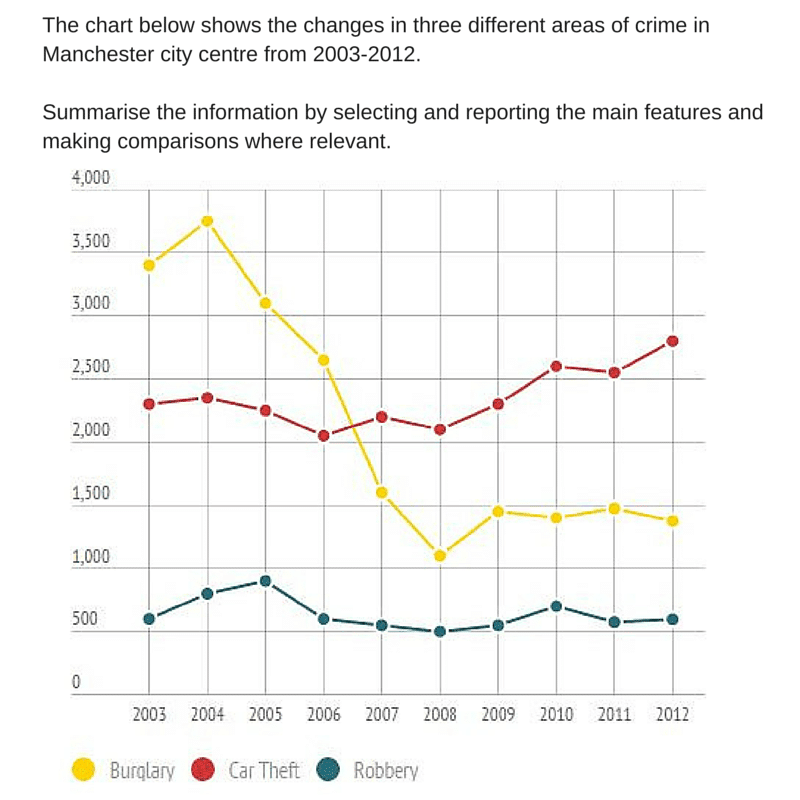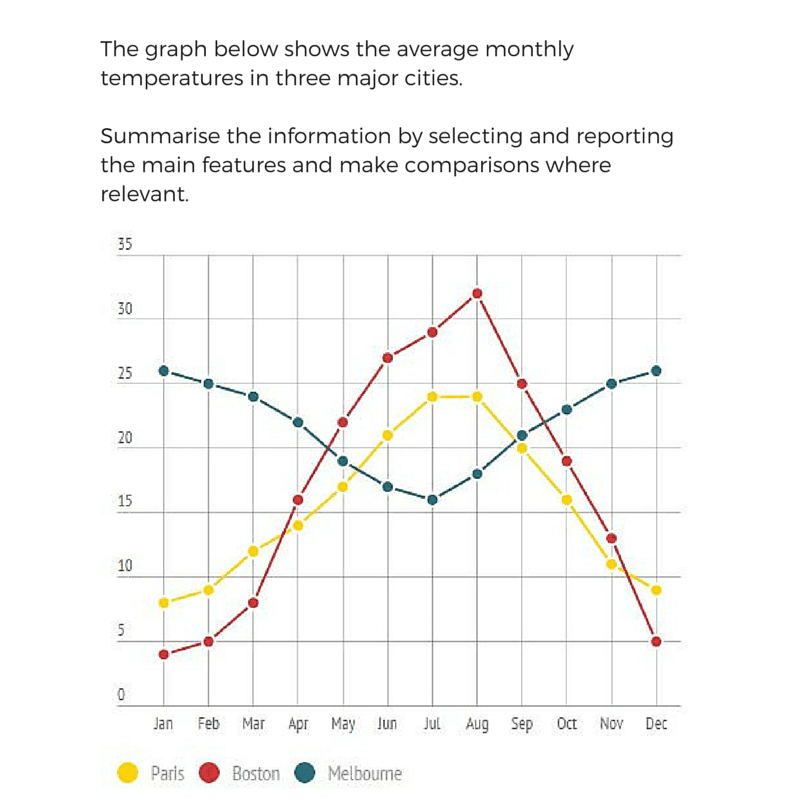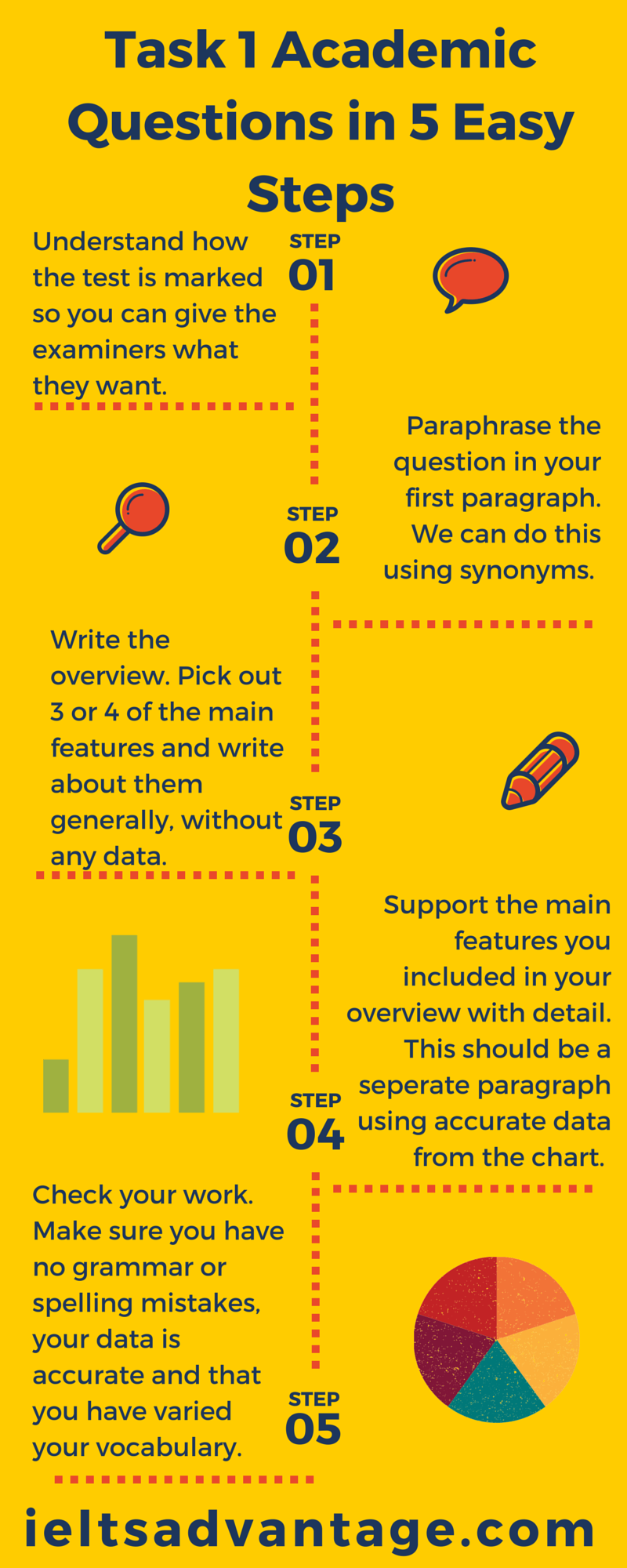Writing Task 1
IELTS Academic Writing Task 1 requires you to write 150 words about data (in the form of a bar chart, line graph, pie chart or table), a process or map. This is a skill many students have not practiced before and don’t do so well as a result. The key to doing well in Writing Task 1 is knowing how your essay is marked and then using this information to give the examiner exactly what they want.
I advise my students to use a 5 step approach:
- Understand the marking criteria
- Paraphrase the question
- Write an overview
- Support overview with detail
- Check your work
By breaking the task down into smaller parts the task becomes much easier. Below I will look at each of the 5 steps in more detail and then give you some sample answers so you can see what it looks like in practice.
Note: Please note that I will be giving you the opportunity to correct my work at the end so if you see some mistakes don’t go crazy in the comments section. Mistakes are intentional to demonstrate the value of checking your work and allowing people to really think about the answer.
We will be using the question below to help us:

1. Marking Criteria
There are four marking criteria for Task 1:
- Task Achievement
- Coherence and Cohesion
- Lexical Resource
- Grammatical Range and Accuracy
Each of these is worth 25% of your total mark.
Don’t worry if you don’t understand what these phrases mean, I will go through each of them in more detail below and explain what they mean in simpler language. You can access the official marking criteria.
Task Achievement
Task Achievement refers to your ability to answer the question properly. In order to do this you have to do all the things the question asks you to do and write a clear, well developed answer.
You will get a higher score if you:
- Select the main/key features of the graph, chart, map or process.
- Write a clear overview that includes the main/key features (main trends, differences, stages etc.) of the graph, chart, map or process.
- Support them with accurate detail.
- Write at least 150 words.
Coherence and Cohesion
Coherence refers to your ability to connect your main ideas together so that they make sense and are easy to understand. This is mostly done at paragraph level. Are your paragraphs in a logical order? Is there one clear main idea in every paragraph? Is it easy to understand the main idea of each paragraph?
You will get a higher score for coherence if you:
- Introduce your essay by paraphrasing the question in the first paragraph.
- Separate your ideas into paragraphs.
- Making it clear which paragraph is your overview.
- Having very clear ideas in your overview.
- Supporting the main points in your overview in separate paragraphs.
- Making it clear what each paragraph is about.
Cohesion refers to the connection of ideas at sentence and paragraph level. Are your sentences and ideas linked together?
You will get a higher score for cohesion if you:
- Use a range of linking words when appropriate.
- Use linking words accurately.
- Do not over-use linking words.
Lexical Resource
Lexical resource refers to your ability to use vocabulary both accurately and appropriately.
You will get a higher score for vocabulary if you:
- Paraphrase the question correctly.
- Vary your vocabulary using synonyms.
- Avoid vocabulary mistakes.
- Spell words correctly.
- Use appropriate vocabulary to describe trends, comparisons, stages, changes etc.
Grammatical Range and Accuracy
This refers to your ability to write sentences with no mistakes and also use a range of grammatical structures.
You will get a higher score if you:
- Do not make errors.
- Use a range of appropriate tenses.
- Use a range of appropriate structures.
- Use both simple and complex sentences.
- Use correct punctuation.
2. Paraphrase Question
Now that we know how the exam is marked we can give the examiners exactly what they want and prevent common mistakes that stop people getting a high score.
Our very first sentence in Task 1 should always be a paraphrase of the question. Paraphrasing is when we rewrite phrase or sentence so that it has different words but keeps the same meaning. We can do this in a number of different ways, but the simplest way is to use synonyms.
For example:
Question: ‘The chart below shows the changes in three different areas of crime in Manchester city centre from 2003-2012.’
Paraphrased: ‘The line graph displays alterations for burglary, car theft and robbery in the centre of Manchester between 2003 and 2012.’
The synonyms we used:
| chart | line graph |
| shows | displays |
| changes | alterations |
| different areas of crime | burglary, car theft and robbery |
| Manchester city centre | the centre of Manchester |
| from | between |
So with a few simple synonyms we have paraphrased the sentence and shown the examiner that we can use this skill effectively and that we have a wide ranging vocabulary, thus two big ticks towards a high score.
This should be your very first paragraph and we should then skip a line to show the examiner that we are starting a new paragraph- the overview.
3. Overview
The overview is the most important paragraph in the whole essay and it is impossible to get a high score if you don’t write a good one.
The question for Academic Task 1 is always the same. It states:
Summarise the information by selecting and reporting the main features, and make comparisons where relevant.
We therefore need to provide a short summary of the main features. You do this in the overview paragraph by picking out 3-4 of the most significant things you can see and writing them in general terms. By general, I mean you do not support anything you see with data from the graph or chart, just write about what you can see at first glance.
A problem students often have is limiting themselves to just three or four things. There is so much information and it can all seem relevant.
When things are complicated in the IELTS exam, think of a way to simplify them. To make this task easier, think about this way: if someone asked you to tell them three things and three things only about the graph what would they be? Thinking this way stops you looking at all the data and focuses your mind on picking out the most important points.
With line graphs we should look out for what happens generally between the start date and the end date.
Let’s look at our example again and pick out the ‘main features.’

If I had to say just three general things about the graph above, they would be:
- Burglary decreases dramatically.
- Car theft increases steadily.
- Robbery remains steady throughout the period.
That’s it. You don’t need to over-complicate it. Just find the three or four most obvious things and pick them out.
We are now ready to take our three main features and add them to our overview paragraph. An overview paragraph should normally be 2 sentences and state the main features in general terms. Never support the main features with data in the overview. Dates are fine, but don’t use any other numbers.
Our overview paragraph will look like this:
The most noticeable trend is that burglary fell dramatically over the period. Car theft fluctuated until 2008, upon which it rose steadily; whereas the number of robberies remained relatively stable between 2003 and 2012.
Again, this paragraph is very simple, clear and easy to read. Please see our Task 1 grammar guide for more ways to describe general trends.
Now that we have finished our overview it is time to support it with more detail in the next two paragraphs.
4. Support Overview with Detail
We reported three main features in the overview and now we must take each of those features and describe them in more detail.
- If we take robbery first we notice that it goes up a little first, then there is a big drop until 2008 when it goes up slightly and then remains steady.
- Car theft goes up and down slightly (fluctuates) until 2008, when it rises steadily.
- Robbery also fluctuates throughout the period but not by much. It rises slightly and drops, then remains steady for a number of years, before rising and falling slightly again.
Now that we have looked at these in more detail we need to put them into sentences.
Burglaries started at just below three and a half thousand in 2003 and apart from a small rise of around five hundred offences in 2004, fell drastically to just over one thousand incidents in 2008. 2009 saw a slight rise to just below fifteen hundred and it remained in and around this figure until the end of the time period.
From 2003 to 2008 the number of car thefts shifted between just below two thousand five hundred and just over two thousand, before rising steadily to nearly three thousand in 2013. Over the entire period robbery never rose above one thousand and did not go under five hundred.
5. Check Your Work
The first draft of our essay looks like this:
The line graph displays alterations for burglary, car theft and robbery in the centre of Manchester between 2003 and 2012.
The most noticeable trend is that burglary fell dramatically over the period. Car theft fluctuated until 2008, upon which it rose steadily; whereas the number of car thefts remained relatively stable between 2003 and 2012.
Burglary started at just below three and a half thousand in 2003 and apart from a small rise of around five hundred offences in 2004, fell drastically to just over one thousand incidents in 2008. 2009 saw a slight rise to just below fifteen hundred in 2009 and it remained in and around this figure until the end of the time period.
From 2003 to 2008 the number of car thefts shifted between just below two thousand five hundred and just over two thousand, before rising steadily to nearly three thousand in 2013. Over the entire period robbery never rose above one thousand and did not go under five hundred.
We now should have a few minutes to check our work for mistakes and see if there are any improvements we could make. This is a crucial stage and you should aim to have at least 3-4 minutes at the end to check and improve everything.
When we check our work we should:
- Check spelling and punctuation
- Check verb tenses. Are they the correct tense?
- Check accuracy of the data used.
- Check vocabulary. Is there any repetition we could remove with synonyms?
- Check paragraphing.
- Check word limit. Over 150?
You should write your answer in pencil so you can make quick alterations.
Check the draft essay above. What changes would you make?
Sample Essay
Here is another question and an example of a good answer so you can see the 5 step system in action.

The chart gives information on average monthly temperatures in Paris, Boston and Melbourne.
Paris and Boston have similar climates; both having lower temperatures between November and March and higher temperatures for the rest of the year, peaking in July and August. Melbourne has the opposite cycle with cooler temperatures between May and August, with the hotter months being from September to April.
Boston’s coldest month is January with an average temperature of just under 5 Celsius and the weather gets increasingly hotter until it reaches a peak of over 30 degrees. It then continues to decline by approximately 5 degrees per month until December. Similarly January is also Paris’s coldest, but with a milder temperature of just below 10 C and it steadily rises until it reaches a peak of just under 25 C in July and August, before becoming consistently cooler until the end of the year.
In contrast, January and December are Melbourne’s hottest months when temperatures average just over 25 degrees Celsius. They then steadily fall each month until they get to a low of around 15 degrees, before getting warmer each month until December.
Summary

